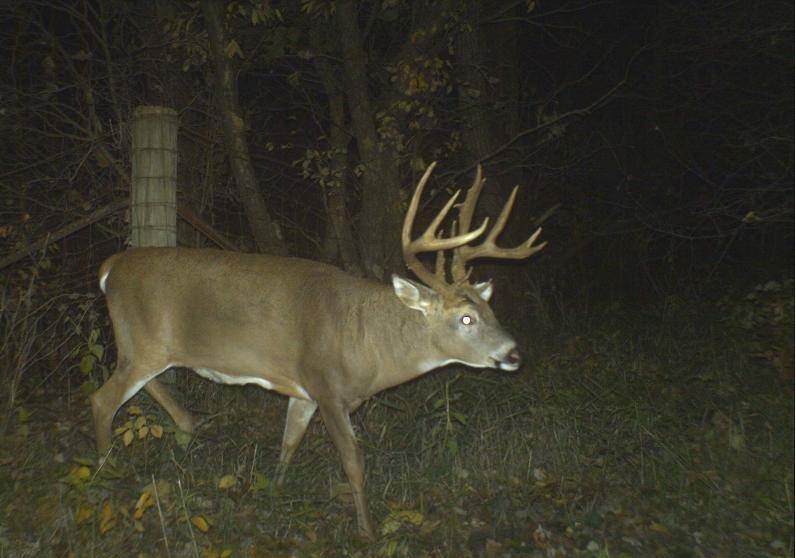Home ranges of whitetails are areas in which they normally live (basically spend most of their time) during spring, summer, fall, and early winter. After that, they migrate and live in wintering areas until the snow melts in spring. They are sometimes forced to temporarily abandon their ranges by hunters or large predators. Lesser antlered bucks (yearlings and mature bucks prevented from breeding) are temporarily driven off-range by dominant breeding bucks beginning about mid-October — 2–3 weeks before November breeding begins — and are generally kept off-range by dominant breeding bucks throughout the two-week breeding period in November. Whitetails are also sometimes drawn off-range by special foods such as falling acorns, combined grain, scarce water, or a doe in heat.
Amazingly, some mature bucks I have photographed off-range appeared to be knowledgeable of areas as large as 16 square-miles. Yearling bucks and does normally live within the ranges of their mothers throughout their yearling year, and it encompasses about 200 acres, though they typically begin to explore short distances off-range in fall and expanding to 450 acres or more. When nearing two years of age, early during their second spring, they are driven off-range by their mothers, then forced to seek and establish their own first home ranges, which could be up to 10 miles away.
Depending on deer densities, home ranges of does with young are approx 90–250 acres in size, averaging about 125 acres. Doe ranges do not ordinarily overlap. They are separated by buffer zones made up of natural features such as openings, roads, hedgerows, swamps, lakes, and watercourses. In habitat where whitetails are not overabundant, there are usually four, sometimes five, doe home ranges in a square-mile.
First home ranges of bucks two years of age are generally 350–900 acres in size. Lesser bucks 3-1/2 to 6-1/2 years of age (bucks that lost battles with one or more other bucks) establish ranges 300–600 acres in size. Most dominant breeding bucks (bucks at the top of their buck pecking orders) establish home ranges at least a square-mile (640 acres) in size. Some larger and more aggressive dominant breeding bucks will have home ranges as large as 1000–1300 acres during the rut, but these ranges shrink to as small as 40 during winter. Ranges of mature bucks generally overlap parts or entire home ranges of other bucks and does, enabling to 3–5 mature bucks, 2–6 yearling bucks, 4-5 mature does, 2-6 yearling does, and 4-10 fawns to live in peace within one square-mile.
Limited food sources and cold winter weather might cause the deer to migrate or to move to winter home ranges. I’ve seen this winter home range shift occur as early as mid-December if the weather turns cold, the snow gets deep, the natural food sources are gone, or agricultural food sources like corn and soybeans are picked or plowed under. If you don’t see any deer in your area, they might have moved or migrated. If they have, you will have to start the scouting, glassing, and patterning process all over again if you want to be a successful deer hunter, and learn what your whitetail does and how they use the surrounding areas around you through the seasons.



















![The Best Deer Camp Chili [VIDEO] Deer Chili Ingredients, Tomatoes, Chili Spices](/wp-content/uploads/2015/10/Deer-Chili-Deer-Camp-Recipe-218x150.jpg)
![How to Call Elk Early in the Season [VIDEO]](/wp-content/uploads/2016/08/byers003-218x150.jpg)




![Idiots Disturb Hunter: How Would You Have Handled It? [VIDEO]](/wp-content/uploads/2015/10/DSC00110-e1474487693878-100x70.jpg)
![Albino Buck Shocked to Shed His Antlers [VIDEO]](/wp-content/uploads/2015/10/AlbinoDeer-100x70.jpg)